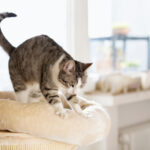It can be concerning and confusing when you notice your indoor cat sneezing frequently. Sneezing isn’t uncommon in cats, but persistent sneezing warrants attention to ensure your feline friend remains healthy. At solcat.net, we understand your worries about your pet’s well-being. This guide explores several reasons why your indoor cat might be sneezing, helping you understand the potential causes and when it’s time to seek professional veterinary advice.
Common Allergies Affecting Indoor Cats
Environmental Allergies: Hidden Home Irritants
Even if your cat lives exclusively indoors, they are still susceptible to environmental allergies. Dust mites, mold spores, and pollen can easily find their way inside your home through open windows, ventilation systems, or even on your clothes. These allergens can trigger an allergic reaction in sensitive cats, leading to sneezing as a primary symptom. You might also observe other signs like scratching, watery eyes, or coughing.
Food Allergies: Reactions to Diet
Food allergies can manifest in various ways in cats, and sneezing is sometimes an unexpected symptom. If your cat is allergic to certain proteins or grains in their food, their immune system may overreact. This reaction can result in sneezing, alongside more typical food allergy signs like vomiting, diarrhea, or skin irritation and itchiness. Identifying the specific food allergen often requires a process of elimination diets under veterinary guidance.
Respiratory Infections: From Common to Chronic
Upper Respiratory Infections (URIs): Cat Colds
Upper respiratory infections, often referred to as “cat colds”, are a frequent cause of sneezing in cats of all ages, including indoor cats. These infections are usually caused by viruses, such as feline herpesvirus and calicivirus, but can also be bacterial or fungal. Besides sneezing, you might notice nasal discharge, coughing, lethargy, and sometimes a decreased appetite. Veterinary consultation is crucial for URIs, as treatment might be necessary to prevent complications and ensure full recovery.
Chronic Respiratory Conditions: Long-Term Issues
Some indoor cats experience persistent sneezing due to chronic respiratory conditions. Feline asthma and chronic bronchitis are examples of such conditions that cause ongoing inflammation and irritation in the airways. These conditions can lead to frequent sneezing, wheezing, and coughing. Regular veterinary checkups are vital for managing chronic respiratory issues, often involving medications to improve your cat’s breathing and quality of life.
Irritants and Obstructions: Foreign Objects and Chemicals
Foreign Objects: Inhalation Hazards
Cats are naturally inquisitive and explore their surroundings with their senses, sometimes leading them to inhale small foreign objects. Grass blades, dust particles, or pieces of toys can become lodged in their nasal passages, causing irritation and sneezing. If your cat suddenly starts sneezing intensely, especially after being in a new environment or playing with a small object, a foreign object could be the culprit. Veterinary attention is needed if sneezing persists or your cat seems distressed, to rule out and remove any lodged object.
Chemical Irritants: Household Products
Household chemicals are often overlooked as potential causes of sneezing in indoor cats. Cleaning products, air fresheners, scented candles, and even certain types of cat litter can release irritating fumes that affect a cat’s sensitive respiratory system. Exposure to these chemical irritants can trigger sneezing and coughing. Opting for pet-friendly cleaning products and ensuring good ventilation can minimize your cat’s exposure to these substances.
Dental Issues: An Unexpected Link to Sneezing
Dental Disease: Infection Spread
Dental disease in cats can sometimes lead to sneezing, a connection that might not be immediately obvious. Infections and inflammation in the mouth, particularly in the upper teeth, can extend to the nasal passages. This spread of infection can cause nasal irritation and trigger sneezing. Bad breath, drooling, and difficulty eating are common signs of dental disease that might accompany sneezing. Regular dental check-ups and professional cleanings are essential for preventing and treating dental problems and their secondary effects.
Tooth Abscesses: Infection and Irritation
Tooth abscesses, pockets of pus resulting from bacterial infections, can also contribute to sneezing. If a tooth abscess develops near the nasal cavity, the infection and inflammation can irritate the nasal tissues, leading to sneezing. A tooth abscess is a serious condition requiring prompt veterinary treatment to resolve the infection and relieve your cat’s discomfort.
Nasal Polyps: Growths in the Nasal Passages
Nasal polyps are non-cancerous growths that can develop in a cat’s nasal passages. These polyps can obstruct airflow and cause various respiratory symptoms, including persistent sneezing, nasal discharge, and sometimes noisy breathing. Diagnosis and removal of nasal polyps by a veterinarian can significantly improve your cat’s breathing and reduce sneezing.
Feline Herpesvirus: A Recurring Viral Issue
Feline herpesvirus (FHV) is a common virus in cats, known for causing respiratory symptoms, including sneezing. Cats infected with FHV may experience recurrent episodes of sneezing, often triggered by stress. While FHV is not curable, managing stress and supporting your cat’s immune system can help reduce the frequency and severity of sneezing episodes.
When to Seek Veterinary Care for Your Sneezing Cat
Understanding the potential causes of sneezing in your indoor cat is the first step in addressing the issue. While occasional sneezing might be normal, persistent or severe sneezing, especially when accompanied by other symptoms like nasal discharge, lethargy, loss of appetite, or difficulty breathing, warrants a visit to the veterinarian. Early diagnosis and appropriate treatment can help ensure your feline companion’s continued health and well-being. Consult with your vet to determine the exact cause of your cat’s sneezing and the best course of action.

